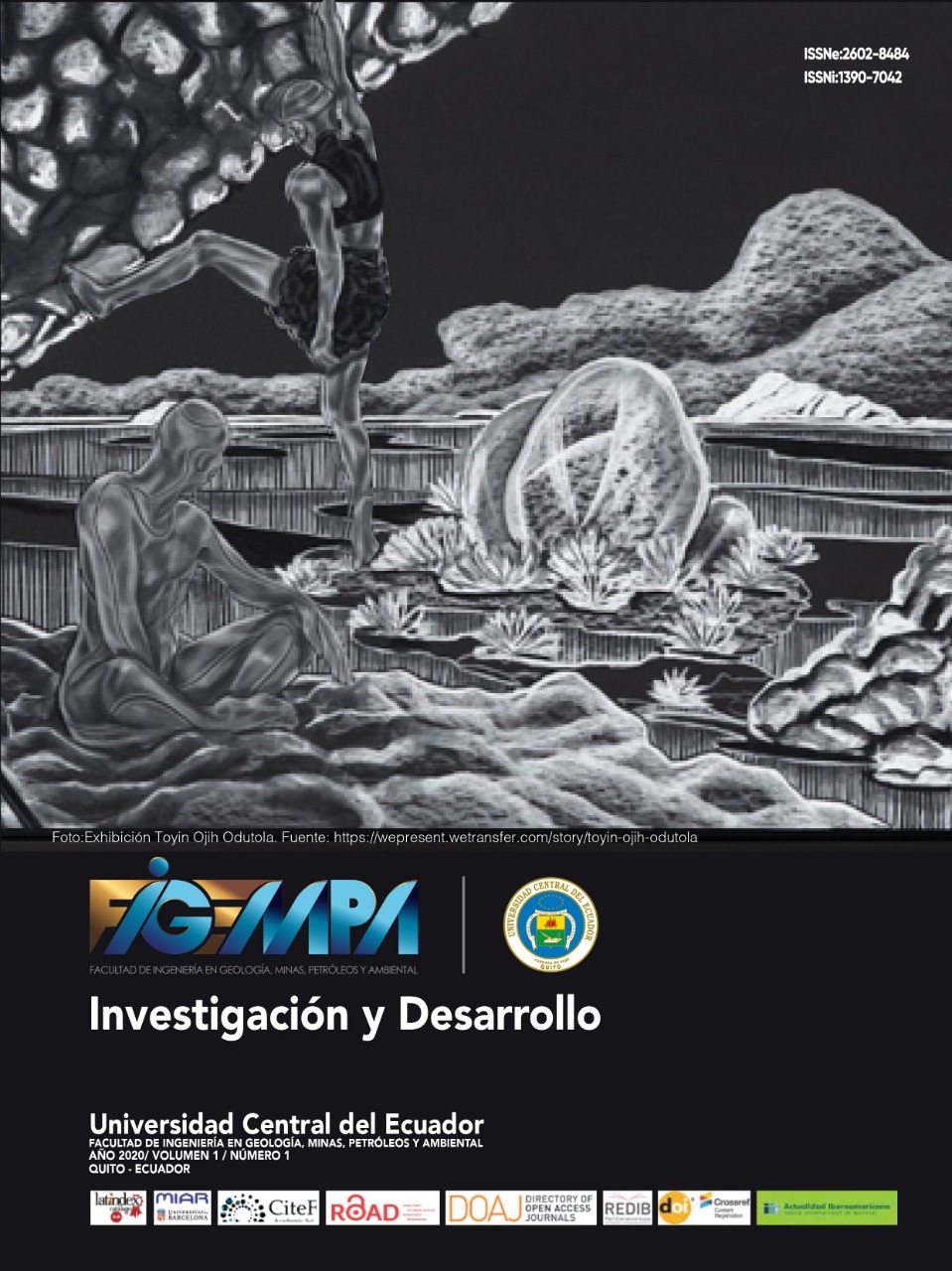Relationship between Tmax and Vitrinite Reflectance in the fore-arc basins of South-West of Ecuador
Main Article Content
Abstract
Quantification of Ro and Tmax are two independent techniques used to constrain the thermal maturity of rocks. Furthermore, several studies have recognized a direct linear relationship between both parameters. In the case of the fore-arc basins of the South-West of Ecuador, we have established an equation [Ro = 0.0228*Tmax – 9.21] based in the data of samples of the Tiburon-0001 and B2-ANX1-1X wells; which correspond to the best quality data. Additionally, a confidence zone was established (Tmax ± 1σ). The samples that fall out of this zone were not considered in further interpretations. The proposed equation has been tested efficient for other pairs of data analyzed in this work and for other basins. The thermal characterization of the South-West of Ecuador shows that two zones may have reached sufficient thermal maturity in order to generate hydrocarbons. The first one is related with late Cretaceous rocks of the Chongón-Colonche Range and with Paleogene rocks of Santa Elena High. The second one is related with Neogene rocks affected by the Puna-Santa Clara fault system. The thermal maturity observed in these zones has been linked with tectonic processes, due to accretionary events (Late Cretaceous and Paleogene systems) and to the Nor-Andean Block scape (Neogene system).
Downloads
Metrics
Article Details

This work is licensed under a Creative Commons Attribution 4.0 International License.
References
Barba D. (2017) Gradiente Geotermal de las Cuencas de Ante-arco del Ecuador. Resúmenes extendidos de las VIII Jornadas en Ciencias de la Tierra, EPN, 5 p.
Barker C., Pawlewicz M. (1994) Calculation of Vitrinite Reflectance from Thermal Histories and Peak Temperatures - A Comparison of Methods, in: Mukhopadhyay, P., Dow, W. (Eds.), Vitrinite Reflectance as a Maturity Parameter. American Chemical Society, 216–229.
Calderón Y., Baby P., Vela Y., Hurtado C., Eude A., Roddaz M., Brusset S., Calvès G., and Bolaños R. (2017) Petroleum Systems Restoration of the Huallaga–Marañon Andean Retroforeland Basin, Peru, in Mahdi A. AbuAli, Isabelle Moretti, and Hege M. Nordgård Bolås, eds., Petroleum Systems Analysis—Case Studies: AAPG Memoir 114, p. 95–116.
Espitalié J., Laporte L., Madec M., Marquis F., Leplate P., Pault J., Boutefeu A. (1977) Methode rapid de caracterisation des rock meres, deleur potential petrolier et leurdegre devolution. Rev. Inst. Fr. Petrol., 32, 23-42.
Grobe A., Urai J., Littke R., Lünsdorf N. (2016) Hydrocarbon generation and migration under a large overthrust: The carbonate platform under the Semail Ophiolite, Jebel Akhdar, Oman. International Journal of Coal Geology, Volume 168, Part 1, 3-19.
French K., Birdwell J., Lewan M. (2020) Trends in thermal maturity indicators for the organic sulfur-rich Eagle Ford Shale. Marine and Petroleum Geology, http://doi.org/10.1016/j.marpetgeo.2020.104459.
Gentzis T., Goodarzi F., Snowdon L. (1993) Variation of maturity indicators (optical and Rock-Eval) with respect to organic matter type and matrix lithology: an example from Melville Island, Canadian Arctic Archipelago, Marine and Petroleum Geology, v. 10, p. 507-513.
Hernández V. (1998) Evaluación Potencial Generador Cordillera Oriental. http://recordcenter.sgc.gov.co/B3/12005000520702/documento/pdf/0101207021101000.pdf.
Issler D. Jiang C., Reyes J., Obermajer M. (2016) Integrated analysis of vitrinite reflectance, Rock-Eval 6, gas chromatography, and gas chromatography-mass spectrometry data for the Reindeer D-27 and Tununuk K-10 wells, Beaufort-Mackenzie Basin, northern Canada. Geological Survey of Canada, Open File 8047, 94 p.
Jarvie D., Claxton B., Henk F., Breyer J. (2001) Oil and shale gas from the Barnett Shale, Fort Worth Basin, Texas (abs.): AAPG Annual Convention, Denver, Colorado, June 3–6, 2001, accessed March 28, 2017.
Jarvie D. (2018) Correlation of Tmax and Measured Vitrinite Reflectance, TCU Energy Institute Notes, 13 p.
Lewan M. & Pawlewicz M. (2017) Reevaluation of thermal maturity and stages of petroleum formation of the Mississippian Barnett Shale, Fort Worth Basin, Texas. AAPG Bulletin, v. 101, No. 12, 1945-1970.
McCarthy K., Rojas K., Niemann M., Palmowski D., Peters K., Stankiewicz A. (2011) Basic Petroleum Geochemistry for Source Rock Evaluation. Oilfield Review Summer, Schlumberger 23, No. 2, 12 p.
Mongenot T., Tribovillard N.-P., Desprairies A., Lallier E., Laggoun F. (1996) Trace elements as palaeoenvironmental markers in strongly mature hydrocarbon source rocks: the Cretaceous La Luna Formation of Venezuela. Sedimentary Geology, 103, 23-37.
Struss I., Artiles V., Cramer B., Winsemann J. (2008) The Petroleum System in the Sandino Forearc Basin, Offshore Western Nicaragua. Journal of Petroleum Geology, v. 31(3), 221-244.

